After publishing yet another Need for Speed review (2011’s The Run, the 12th NFS game we’ve covered), my friend and colleague had a suggestion: some kind of series overview might be useful.
Given that the NFS brand has lent itself to a few different types of racing game over the years, with useful identifiers like numbers abandoned fairly early on in favour of more opaque naming practices like reusing the exact same titles, it seems like a worthwhile exercise.
So here’s a brief rundown. The timespan is of NFS titles already covered on FFG, and only games that could be one day eligible for review, i.e. released on PC, will be featured. In other words, we will briefly look at any missing entries thus far, but won’t go beyond The Run for now. (Oh, and while we’re at it, 2010’s now-defunct online-only Need for Speed: World has also been skipped).
[2022 EDIT: We’ve crept into 2012 now, and beyond The Run, with Criterion’s version of Most Wanted…]
Links to write-ups will be provided along the way, so you can rejoice both in some dusty old opinions and our habit of covering games from a series in a rather haphazard order.
The Need for Speed
Released: 1995
Review date: April 2004
Review score: 5
What we said: “On more tricky courses the cars’ handling seems too woolly and unresponsive, and twisty sections of track are difficult to navigate without that invisible wall coming into play. However, despite this, NFS still entertains. The thrill of the road race remains: there is a great sense of speed, facilitated by some very straight sections of road that really let you put your foot down.”
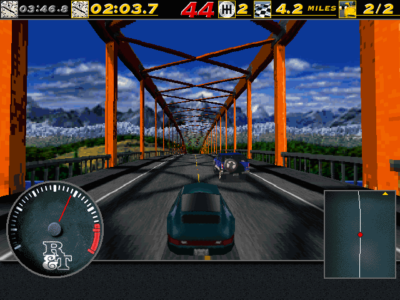
The Need for Speed was originally a 3DO exclusive, but like many of the better games on that system, once it died a death, ports to the PC or PlayStation soon followed. TNFS was what fans of the Test Drive series wanted next: fast cars on real roads with some properly good 3D graphics. (It also provided what developers thought CD-ROM owners of the time wanted: lots of unnecessary video clips of cars driving in slow motion while some widdly guitar music plays over the top.)
The game was great to look at, with some stunning scenery, while the chases contained an element of cat-and-mouse that was never really a feature of later instalments: alerted to a police presence by the bleeps of your radar detector, you could try and slow down to avoid any trouble. And if a pursuit was initiated, it would come to an end as soon as the cop car got past you, which added some extra tension.
On the other hand, the stodgy handling and solid invisible walls surrounding the tarmac ultimately undermined the feeling of open road freedom that it was striving for. And indeed, only 3 of the 6 available courses actually are on roads with civilian traffic – the others are closed circuits.
A special edition, featuring additional tracks and Windows 95 support, followed in 1996.
Need for Speed II
Released: 1997
Review date: September 2021
Review score: 4
What we said: “Having treated this game with casual disregard for so many years led me to think of it – erroneously – as some kind of outlier, with the fairly obvious conclusion that it might represent a middle point of transition between the first and the third NFS titles somehow coming as a surprise. You can definitely see traces of NFS III: Hot Pursuit here, while the leaden handling and chunky car-flip crashes remain from the first game.”
On the surface, this first sequel seemingly changed very little, yet the removal of the police chase element – one of the original’s defining features – was significant, while the courses also veered away from reality towards a theme of novelty regional tracks. Reviews were mixed, with some considering it a disappointing follow-up.
A special edition featuring additional cars and tracks, as well as adding 3dfx support, was released later the same year.
Need for Speed III: Hot Pursuit
Released: 1998
Review date: May 2004
Review score: 7
What we said: “The admittedly enjoyable police chases are somewhat contrived. For a start, the courses are not sections of road, but in fact tracks wearing [duh-duh] road trousers…Still, Hot Pursuit remains an entertaining game.”
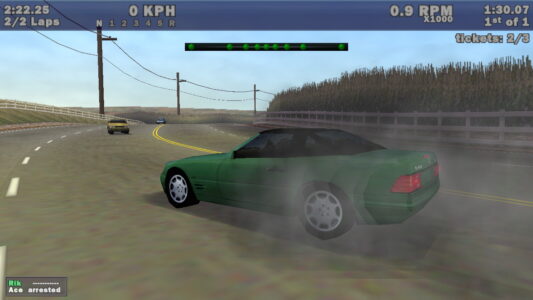
Call it coincidence or the result of corporate committee thinking (or, you know, responding constructively to criticism and feedback) but for whatever reason, EA decided to follow up the entirely police-free NFS II with a third game based almost entirely around being chased by the cops. For the first time, you could also switch sides and play as the pursuer rather than the pursuee, chasing down those no-good pesky racers and deploying tyre-shredding spike strips at will.
Despite the slightly over-the-top police tactics, and the abandonment of point-to-point racing in favour of laps around tracks wearing – yes, this was where we coined the phrase – road trousers, NFS III was a return to form. The blippity-blops of the radar scanner were also upgraded to a full police radio, offering a full running commentary on the pursuit (“In pursuit of the sports car…he’s going over 150!”) which became an intermittently recurring feature throughout the series.
At this point in the series, a sustained career mode of any kind was absent, with the focus being on successfully evading capture on each track, or completing the equivalent police challenges, or just mucking about.
Need for Speed: Road Challenge
Released: 1999
Review date: June 2007
Review score: 6
What we said: “In theory, we should have no hesitation in recommending Road Challenge over Need for Speed III…Unfortunately, though, I just didn’t enjoy this game very much. The career mode is dull and adds very little, while the changes to the ‘Hot Pursuit’ mode aren’t really for the better.”
The aforementioned career mode was bolted onto this follow up, also known as High Stakes in the US, and the first NFS game to drop the number from its title, perhaps to justify the lack of significant progress from Hot Pursuit.
The two games had so much in common, it was tempting to take the superficial improvements (such as weather effects and vehicle damage) at face value and deem it a superior game, but the joy of its predecessor was notable by its absence, and your correspondent retains the feeling that he was a little too forgiving in his admittedly ancient write-up.
That seems like an odd thing to say when Road Challenge even includes all of the tracks from NFS III as unlockables but playing it caused me to doubt my fondness for Hot Pursuit, seemingly making its already slightly weird hovercraft-style handling even worse. Plus it was severely deficient in terms of excitement, beyond the police chases, which the career mode ignored.
Need for Speed: Porsche 2000
Released: 2000
Review date: May 2007
Review score: 8
What we said: “Porsche 2000 represents something a little bit different for the Need for Speed series. Superficially it may resemble the two games that preceded it…but much has been changed underneath. While NFS III is the kind of game you can dip into for a quick race, Porsche 2000 offers two lengthy and focused single-player career modes that can keep you entertained for longer periods.”
Another reworking of the NFS III engine, EA’s spin this time was to push manufacturer exclusivity for this entirely Porsche-based title, forgetting that no-one, not even Jeremy Clarkson, cares about such things. Swapping a variety of licensed manufacturers and models for a variety of very similar-looking Porsches proved to be a hard sell, and indeed the game was a commercial flop.
Which was a shame, as Porsche 2000 – known as Porsche Unleashed in the US – was arguably the most accomplished of the 90s NFS games, with much-improved handling and a varied and a couple of interesting career modes, including Factory Driver, a low-budget and no-frills type of storyline compared with what was to follow later in the series, but a storyline nonetheless.
We sort of shocked ourselves by putting it ahead of NFS III, to the extent that it now sort of seems like a mistake, but it definitely wasn’t.
Need for Speed: Hot Pursuit 2
Released: 2002
Review date: October 2017
Review score: 4
What we said: “Playing Hot Pursuit 2 feels like playing Road Trousers: The Game. Despite actually featuring point-to-point races, and being superficially faithful to the spirit of the series, something isn’t quite right here…very little of what first made Need for Speed distinctive and special remains.”
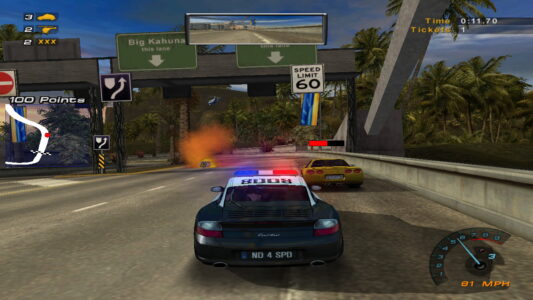
The relative failure of Porsche 2000 may well have prompted some soul searching, or at least a meeting or two, over at EA, who gave the series a rest in 2001. When it re-emerged a year later, it seemed to be a case of going back to the last thing that worked: the police chases of Hot Pursuit. Hence the slightly confusing name (which PC Zone reviewer Steve Hill memorably likened to naming a film Jaws 3D 2: Sharp Teeth).
At this point in the 00s, though, the supercars of old were starting to seem a bit dated and uncool. The PC version was also a curiously unexciting affair, and despite the virtual cops having access to helicopters that dropped exploding barrels on the road, the pursuits were lacking in tension and excitement.
Even though Hot Pursuit 2 moved the action back onto the roads after Porsche 2000 focused more (but not exclusively) on track-based racing, it now seemed further away from the action/sim roots of the original than ever, with the unforgivable dropping of vehicle dashboards (heresy!) a sign that the series was moving towards generic arcade territory.
Apparently the PS2 version, developed by EA Black Box, future custodians of the series (from 2003-2008, plus a 2011 swansong), was a lot better.
Need for Speed: Underground
Released: 2003
Review date: September 2009
Review score: 7
What we said: “You may not like it when you hit a tree that brings you to a complete standstill midway through a race that you’ve been leading all the way, but it does make the remainder pretty exciting. And the bit at the end of the drag race where you have to be in the right hand lane to hit the ramp that launches you over the moving train may be slightly contrived, but it’s satisfying when you get it right.”
Widely characterised, including by FFG, as a cash-in on the success of The Fast And The Furious, the decision to move from the wobbly-belly-over-the-jeans Clarkson crowd to the tattoos and chiselled muscles of the street-racing world gave the series some long-overdue momentum.
Taking the action from the open road onto the claustrophobic night-time streets (with dashboards now gone forever), Underground‘s visual sheen and edgier presentation may have been cynically conceived but it was a mightily effective approach, giving us the most exciting NFS for some time.
And yes, you did have to out up with some daft cut-scenes, supposed street lingo and compulsory pimping of your ride (not to mention some great/awful music) but beyond the gimmicks, there was a solid racer there, keeping the complication of civilian traffic (but not the police) from earlier NFS titles, and mixing up traditional circuit and point-to-point events with those requiring mastery of drift and drag racing. On the negative side, this game did start a tradition of career modes that required a grind through millions of similar events, as well as some rather unforgiving rubber band AI.
Your correspondent rated it below rival contemporary Midnight Club II, but it’s entirely possible he could have been wrong.
Need for Speed: Underground 2
Released: 2004
Review date: January 2018
Review score: 7
What we said: “I underestimated the original Underground, and there was a certain white-knuckle intensity about that game’s latter stages which is missing here…There is however also a feeling of a series on the up…it’s also true that UG2 adds elements that aren’t of much personal interest to me, but might be to others.”
Underground 2 was largely more of the same street-racing action, adding a slightly more detailed story (featuring actor-slash-model Brooke Burke) and an open world map that in theory allowed you more freedom to explore, choose your next race and indulge in non-race events with fellow street racers, but mainly resulted in you having to spend more time driving to races and trying to find upgrade shops and garages to make sure your car had been upgraded to the highest possible level of ludicrousness.
That said, it was a tasty accompaniment to the series and added just enough variety to differentiate it from its predecessor. Less appetising, however, was the extremely uncool and all-too intrusive brand partnerships with the likes of Campbell’s Soup and Burger King, while the soundtrack unfortunately lacks the impact of the previous game’s.
Need for Speed: Most Wanted
Released: 2005
Review date: December 2011
Review score: 9
What we said: “In some ways, Need for Speed: Most Wanted feels like just another game in the series. Structurally and technologically, much of the racing is only a small evolutionary step away from its immediate predecessors. Yet, by combining the racing with a law-evading element, the career mode becomes a more varied and digestible challenge than in previous years. Moreover, the return of the police to the series is an appropriate one, reminding long-term fans why they became interested in Need for Speed in the first place.”
The formula for the success of Most Wanted was simple: dial down the night-time street racing angle and reintroduce the police chase element that was previously considered integral to the series. Attempts to bolster the storyline were increased, with the introduction of possibly deliberately bad (but probably not) video cut scenes featuring real actors.
Said story was based around silly bad boy Razor nicking off with your BMW and the player fighting through the list of the fictional city of Rockport’s most wanted (Most Wanted) racers by competing in roughly 30 million races and stirring up trouble with the police, led by the aptly-named Sergeant Cross, along the way. Assistance was provided by Josie Maran, who also fulfilled the role of “character who warns you in the introduction to wear your seat belt and not drive like a maniac in real life”, and a mysterious character called “Rog” who bombards you with advice via text message.
The police chases added a real sense of white knuckle tension, forcing you to stir up a lot of trouble and then lose it again, just to bolster your reputation. Scenery could be destroyed to distract the pursuing hordes as you desperately searched for a hiding place, before heading back to the garage to respray and remodel your car to avoid further unwanted attention.
Need for Speed: Carbon
Released: 2006
Review date: June 2015
Review score: 6
What we said: “It seems as if, since Underground, EA have been using the same basic materials, adding and subtracting a few bits, and twisting a few dials here and there, to come up with a slightly different game. With Most Wanted, all the tinkering added up to an optimal experience, so it was probably a mistake to try the same trick again.”
If Underground was about street racing, and Most Wanted was about police chases, then Carbon was about…canyon battles I guess? They sort of seemed original to me at the time but at that point I hadn’t yet played UG2, which featured similar twisty-turny downhill races.
Carbon‘s story was a direct continuation of Most Wanted, one in which the player character somehow manages to again lose his precious BMW at the start of the game, this time in an encounter with the returning Sergeant Cross, who has – equally inexplicably – now left the police and operates as a bounty hunter. Bad boy duties were passed to the guy who played Helo in the Battlestar Galactica reboot, while Emmanuelle Vaugier from CSI: New York has the female lead (and hence takes the “wear your seat belt” duties).
The racing is a mixed bag, a significant step down from Most Wanted despite retaining police chases. There’s some half-baked stuff about assembling a racing crew and using wingmen to help you, which doesn’t add much, and the difficulty level seems to have been toned down significantly.
On the plus side, there’s a more stylised affectation to the graphics, which works well – the return to night-time racing bathing everything in a futuristic blue neon glow, while crew-members and other racers dress like sci-fi villains. The soundtrack is also possibly the best of the series (we’ll be writing more about soundtracks soon).
Need for Speed: ProStreet
Released: 2007
Review date: January 2020
Review score: 4
What we said: “Ultimately, a lot of ProStreet‘s problems do come down to trying to shoehorn the previous Black Box games into a format that doesn’t play to their strengths and only serves to highlight their weaknesses. The end result is a substandard and unexciting affair that lags behind the likes of TOCA Race Driver, a significantly older game, in terms of what it’s trying to do (right down to featuring a protagonist called Ryan).”
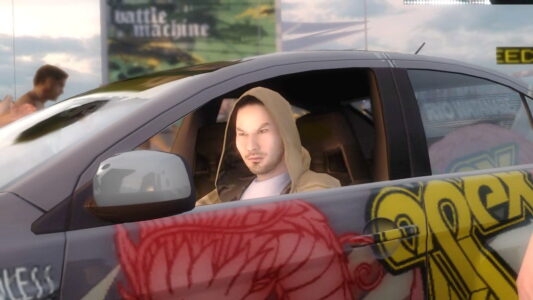
Aiming for a Race Wars-type vibe, ProStreet retained all of the series’ street-racing baggage while confining the action to desert tracks. Handling has never been the series’ strong suit, so veering into more technical track-based racing wasn’t the best move.
Although the camp video cut-scenes of ProStreet‘s immediate predecessors no longer featured, a storyline of sorts was retained, based around a plucky young upstart called Ryan (that’s you) moving from the world of street racing into more legitimate territory. Current champ, ‘Showdown King’, Ryo Watanabe, keeps showing up to diss you publicly as you hammer through the career mode’s many races in the hope of one day dethroning him.
While there was perhaps merit in a change of tack, a more fundamental revision of the driving model was necessary to make a more simulation-focused approach work successfully, and although the game does have its moments, at times some of the driving, particularly during lap-based events, is genuinely quite awful.
Meanwhile, in the UK, EA got itself into a bit of hot water by promoting the game with pictures of topless models in the pages of The Sun newspaper.
Need for Speed: Undercover
Released: 2008
Review date: May 2017
Review score: 5
What we said: “In a desperate bid to return to a winning formula, [Black Box] haven’t delivered more of the same, but something that’s worse. There’s something here for fans of lightweight arcade racers, and those interested in the history of the series, but otherwise there’s little reason for anyone else to check it out.”

With ProStreet not being all that successful, it was back to the streets for NFS and an attempt to recapture the glories of Most Wanted. Sadly, pretty much everything that Undercover did, the series had been done before and better.
The ruse this time is that you are actually a cop who needs to go deep undercover (Undercover) in the world of street racing in order to solve some crimes. The story is slightly more complicated, although no less ludicrous than before, while Maggie Q features as the main star of the cut-scenes.
Little new was added to the action, save for some unsatisfactory GTA-style missions that frankly don’t have any business in a NFS game. Meanwhile, the presentation, handling and performance of the cars seemed to be becoming less and less important. Undercover wasn’t entirely without merit, but by this point the series was showing clear signs of running out of ideas.
Need for Speed: SHIFT
Released: 2009
Review date: January 2021
Review score: 7
What we said: “Whatever else you might say about Need for Speed, it’s not about track racing. You may quibble about the cynical ‘street’ aspect of 00s NFS, but there was still a core of roads, traffic, and police chases that maintained some links to the original. This looks like what it is: EA hired some people with decent sim pedigree to make them a game.”
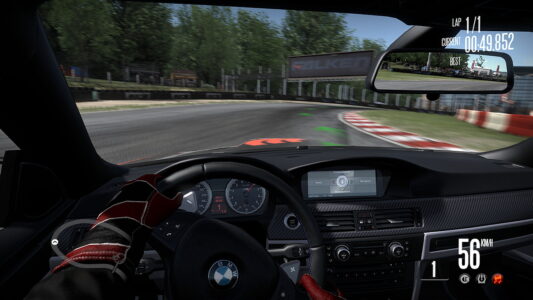
Two duds in a row forced EA back to the drawing board again, with the plan being to farm the NFS name out to different developers and extend the amount of time each had to work on their game.
Developed by Slightly Mad Studios, itself formed by ex-SimBin employees who had been responsible for the well-received GTR racing sims in the mid-00s, SHIFT was a shift (sorry) towards that kind of territory.
Depending on your perspective, SHIFT was either a NFS game in name only or a more successful version of what the series was trying to do with ProStreet. It received a reasonable reception, even if it didn’t quite touch the console kingpins – the Gran Turismos and Forza Motorsports of this world – while long-time fans of the series questioned whether this is what they really wanted from the NFS brand.
At least the in-car view – and dashboards – returned. And, judged on its own merits as an arcade/sim track racer, it was a solid effort, with the tail-end of the career mode providing some genuinely thrilling moments.
Need for Speed: Hot Pursuit
Released: 2010
Review date: July 2018
Review score: 9
What we said: “Hot Pursuit is a triumph: a successful reinvention of the series and the the kick up the arse it needed, boiling it all down again to the thrill of driving fast and dodging police. There are echoes of the Burnout games, but even if you’re not a fan of those in general or even the fêted Burnout Paradise in particular, there’s enough NFS in here to distinguish Hot Pursuit as a part of this series, of which it certainly establishes itself as a highlight.”
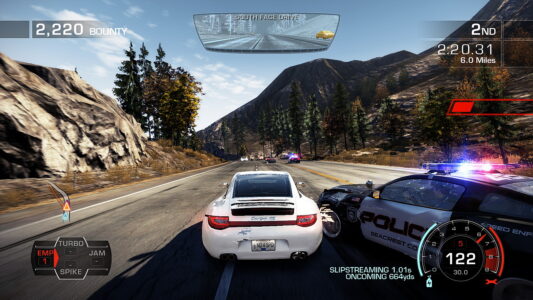
Next on the NFS merry-go-round was Burnout developers Criterion, who decided to strip the series back to basics – driving fast cars in a straight line while evading the cops – with some success. Re-using the Hot Pursuit brand may have been slightly confusing (it’s not a reboot of a long-running horror film series) but I guess it did reinforce the fact that this game represented a break from the street-racing era of the 00s.
Storylines were abandoned completely, there was absolutely no need to customise your vehicle (except from choosing a colour), and pretty much everything from the Black Box era was stripped away. Meanwhile, the police chases somehow pull off the feat of being both completely over the top and ridiculous without interfering with the flow of the racing itself.
As with previous Hot Pursuit games, you could switch sides and play as the police, with the two career modes – as racer and police officer – running in parallel, allowing you to switch between them at will as you progress.
Purists perhaps felt that Hot Pursuit was too much Burnout and not enough Need for Speed, but speaking as one of the few people not to think that Burnout Paradise is one of the greatest racers of modern times, I really liked this one.
SHIFT 2: Unleashed
Released: 2011
Not reviewed
Perhaps recognising the confusion caused by taking the series in so many different directions, the NFS name was taken away from this sequel to SHIFT, although it technically still remains part of the series.
Like its predecessor, it was received fairly well without ever being considered a genre leader. And there was to be no SHIFT 3.
Need for Speed: The Run
Released: 2011
Review date: March 2019
Review score: 6
What we said: “Despite all its faults, The Run is a game you can play again and again. The short run time and gentle difficulty makes it possible, and for once you don’t feel like everything has been strung out through endless repetition of the same elements. There are moments of pure joy, too, be it weaving through traffic on the Altamont Pass with wind turbines lining the highway, or the amazing section in the Rocky Mountains of Colorado.”
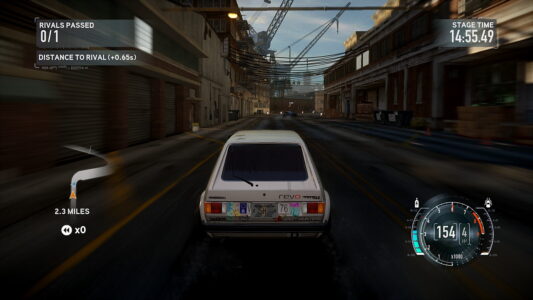
The hiatus for Black Box, and their involvement with the series, ended with The Run. Some pre-release excitement was stirred with talk of a coast-to-coast race across the USA, a storyline and a promo movie shot by Michael Bay. Sadly, most felt that it missed the mark badly, citing the short running time, unnecessary QTE sections and sub-par AI among the main complaints.
I’d also add others, including the crappy action set pieces and extremely dislikeable main character Jack. Plus it wasn’t really as different from earlier titles from Black Box as you might have hoped, given the additional development time.
But, pick beneath a lot of the annoyances and irritation, and there’s a good game there, one which allows you to pick a car and race it through some beautiful scenery and a variety of weather conditions, with the occasional police chase thrown in for good measure.
Need for Speed: Most Wanted (2012)
Released: 2012
Review date: June 2022
Review score: 5
What we said: “Most Wanted (2012) seems to have been conceived from a position of misunderstanding not only what the previous Most Wanted game was, but also Criterion’s achievements in delivering Hot Pursuit so successfully. Add into the mix EA’s abandonment of the studio’s Burnout franchise despite the strong critical and commercial performance of Burnout Paradise and you start to make sense of what we ended up getting here and why.”

With The Run deemed a failure, EA went back to Criterion to get them back on track with another revival, this time of the Most Wanted name.
Unfortunately, this time, the end product wasn’t an unqualified success, with elements of Hot Pursuit, Most Wanted (2005) and Burnout Paradise sitting uneasily alongside each other and failing to generate much excitement.
Criterion were keen to emphasise the multiplayer and social aspects of their version of Most Wanted, but for the single player the main event was over in a matter of hours, and with precious little fanfare.
The game was reasonably well received by contemporary reviewers, but anyone looking for a repeat of the thrills offered by Hot Pursuit or the previous iteration of Most Wanted is likely to be disappointed.
Need for Speed: Rivals
Released: 2013
Review date: May 2025
Review score: 6
What we said: “Though the series has subsequently been rebooted and endured into a fourth decade, for me, Rivals does feel like the end of something. On its own merits, it’s a perfectly ok-to-good arcade racer, which may tick some boxes for those who haven’t played a NFS game in a while (or at all), but for longer-time fans, it may feel like it has little new to offer.”
Blending elements of the previous three road-based NFS games, Rivals wrapped the action around a low-key two-sided story of pursued and pursuer, during which extremely serious voiceovers attempted to convince you of the gravity of their multi-stage battle for supremacy on the roads of Redview County.
It was perfectly alright, echoing good moments from plenty of previous games, but doing little more than that. The ‘opt-out’ nature of its online functionality, and the resulting inability to pause the game, also provided moments of minor irritation.
—
And that’s as far as we go, for now. As we said, this piece will be updated if, as seems likely, we end up covering any of the games already listed, or any newer NFS titles.

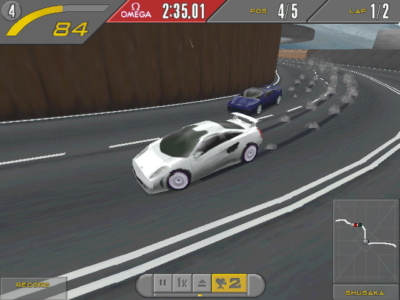
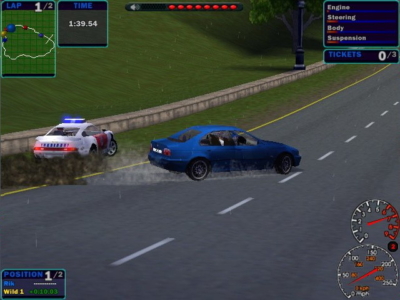
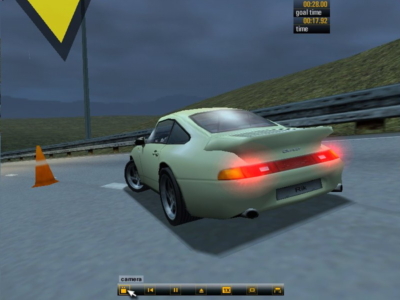
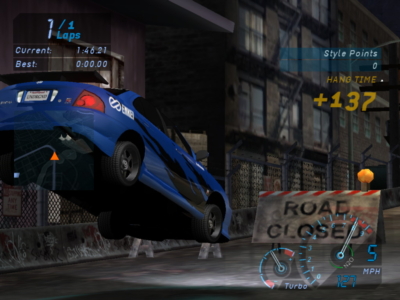

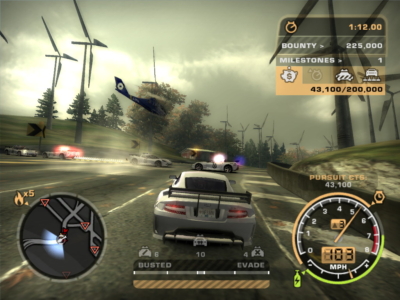
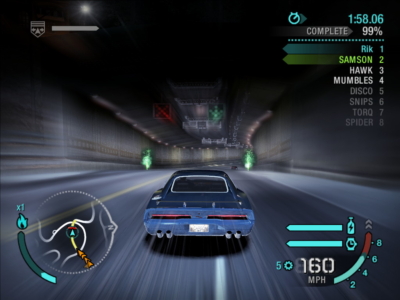
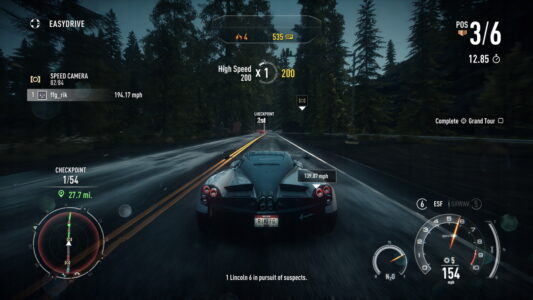


 Posts
Posts
Hot Pursuit 2 deserves a higher score, while both Underground 1 and 2 deserves a lower one (and not only because of their awful soundtracks : drift was a nightmare too). Apart from that, nice paper.
With a Radeon 9600 on 98SE, I remember having to use the NFS Porsche rasterizer in order to run all the previous titles (which would else crash or not run at all) : a tribute to the developers and their inner API.
April 14, 2019 @ 6:25 pm
Hot Pursuit 2 definitely stands out as one of the weaker ones to me, certainly compared to the two UG games. (Although it’s been a while since I played some of the older entries in the series…)
April 15, 2019 @ 1:04 pm
Rik, we won’t agree about these points. But who cares ? Not even I. 😉
After all, all that matters is that we agree about Crapday and Test Drive Unlimited ratings. 😉
Weakest : ProStreet, Undercover, Shift. Weak : both Underground. Best : Porsche, Most Wanted (the first one, don’t know about the remake), NFS III.
Note I’ve replayed all NFS from the first to Shift in 2017, and I did not bother to retry Underground for more than a few hours. Eye candy and Fast & Furious style don’t make for a good game.
Just for info : Juiced and Juiced 2 CDs went to garbage can. Midnight Club II is still installed on my PC with Richard Burns Rally, NFS Most Wanted and Test Drive Unlimited.
April 15, 2019 @ 9:04 pm